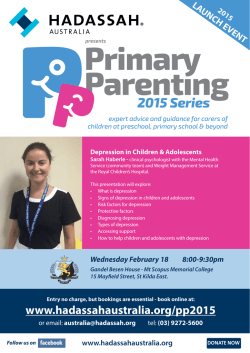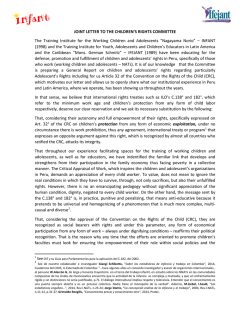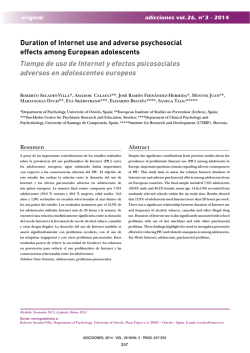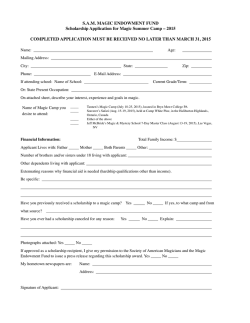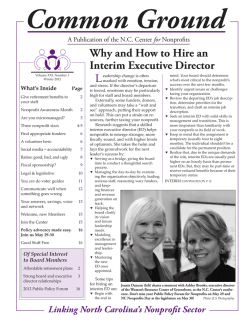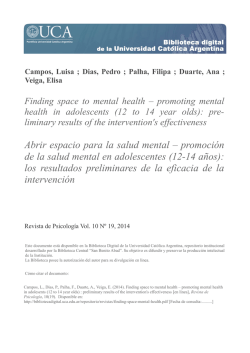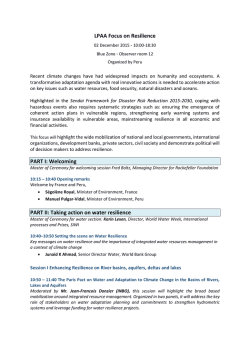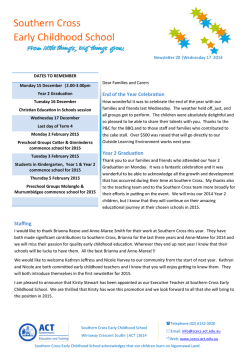
Youth Experience & Aspirations
XQ MODULE NO. 02 / DISCOVER YOUTH EXPERIENCE & ASPIRATIONS What can we learn from adolescents? The voices of adolescents provide valuable insights. They are necessary in designing the blueprints for the schools that will serve them. YOUTH EXPERIENCE & ASPIRATIONS XQ MODULE NO. 02 / DISCOVER 2 XQ Schools will help young people invest in their own learning, identify their aspirations, and create pathways to success in and out of school. YOUTH EXPERIENCE & ASPIRATIONS XQ MODULE NO. 02 / DISCOVER 3 How can we empower young people to contribute to conversations about education? How can we encourage adults to listen deeply to young people? YOUTH EXPERIENCE & ASPIRATIONS XQ MODULE NO. 02 / DISCOVER 4 THINGS TO THINK ABOUT Young people need an engaging, high-quality learning environment in order to grow. How will you discover what features an environment like this should include? What roles will adolescents play in creating such an environment? What do young people think about the schools that are currently available to them? Consider what opportunities young people in the community you wish to serve might already envision for their future, and think about what cognitive and life skills they’ll need to reach their goals. Where—besides school—are young people in the community learning? What types of experiences are available? What patterns do you see? YOUTH EXPERIENCE & ASPIRATIONS XQ MODULE NO. 02 / DISCOVER 5 LISTEN AND LEARN YOUTH EXPERIENCE & ASPIRATIONS XQ MODULE NO. 02 / DISCOVER 6 FACT: Young people are the best judges of how they experience high school. Youth perspectives must inform all aspects of your work. Listening to young people’s authentic perspectives is incredibly important— after all, they’re the ones our schools must serve! It is empowering to adolescents when they feel adults are authentically engaging them in the decisions that affect their lives. So what are you waiting for? Go out and talk to the youth that your school will serve–a local community center is a really good place to start. They can give you relevant, up-to-date insights that you may not have access to. Invite them to reflect on occasions when learning has been deep and rewarding for them. Ask them about experiences that they wish had been more fulfilling. Be sure to seek out the opinions of youth whose voices aren’t often heard, including those who are struggling in school and those who have dropped out. How can you incorporate the information you gather into the design of your school? TRAVIS J. BRISTOL, Research & Policy Fellow Stanford Center for Opportunity Policy in Education THINK ABOUT What do adolescents think of their schools? What experiences inform their views? What do they imagine an engaging learning environment would look and feel like? StoryCorps, a nonprofit story archive, has a great list of questions to ask people about school: + Do you enjoy school? + What kind of student are you? + What do you do for fun? + How would your classmates describe you? + What are your best memories of grade school/ high school/college/graduate school? Worst memories? + Is there a teacher or teachers who had a particularly strong influence on your life? + Do you have any favorite stories from school? Find inspiring student–educator interviews in the archive: http://storycorps.org/themes/teachers/ WATCH YOUTH EXPERIENCE & ASPIRATIONS with Travis J. Bristol DEGREES OF YOUTH PARTICIPATION INTEREST-BASED LEARNING We can learn from young people in a range of ways. UNICEF shares a visual describing the eight levels of youth participation, from nonparticipation to child-initiated decision-making. Young people are natural learners. How can your school bring out the curiosity and excitement in every student? Edutopia shares some lessons on learning outside the classroom, from robotics to gardening. EXPLORE READ YOUTH ENGAGEMENT THE NEW YORK TIMES LEARNING NETWORK How can adults use youth experience and aspirations to guide school decisions? The Forum for Youth Investment offers materials to help young people play meaningful roles in community change, as well as education policy and advocacy. Check out the student opinion blog on the New York Times’s Learning Network, where students are invited to give their opinions on current news. READ EXPLORE YOUTH EXPERIENCE & ASPIRATIONS XQ MODULE NO. 02 / DISCOVER 8 FACT: Young people must feel empowered to take charge of their own learning journeys. We need to support our youth. Positive academic outcomes are strongly linked to social and emotional well-being. Factors like physical health, self-esteem, family support, and participation in clubs and organizations have an effect on how well students do in school. It’s also important to recognize that young people aren’t just in school or out of school. Regardless of enrollment status, learning comes at them from all directions—via family, community, social networks, and other everyday experiences. There is evidence that building resilience in low-achieving students can have a positive impact on their academic performance. Child Trends, a nonprofit, nonpartisan research center, offers schools the following strategies for building resilience in students: + Promote positive connections between staff and students, students and students, and school and home. + Nurture and use qualities like empathy, optimism, and forgiveness. + Don’t focus on failure or negative behavior. + Teach by example. + Show students how to work out difficulties by reflecting on them. + Foster feelings of competence and efficacy. THINK ABOUT Where in the community do adolescents collaborate with adults to accomplish a shared goal? What types of behaviors do you see? How does this help you rethink in-school activities? WE THE STUDENTS “All students are entitled to pursue opportunities which can have a positive effect on the world beyond their classroom, and receive academic support where such opportunities develop their sense of civic responsibility and knowledge. Students may partake in such projects which aim to solve contemporary issues and propose such projects as experiential or independent learning endeavors as eligible for school credit.” STUDENT BILL OF RIGHTS, Student Voice In order to fully support all of our young people, schools must make an extra effort to involve parents and families in meetings, events, and activities where they can make genuine contributions to their children’s education. WE THE STUDENTS YOUTH ENGAGEMENT AND EQUITY What do our students deserve in school and as individuals? The Student Bill of Rights was developed by the students at Student Voice. Read more and join the movement! What do schools need to do to engage young people and their families? How can deep engagement actually increase equity? Ronald Ferguson, Heather Weiss, and their collaborators share six principles that will help us engage youth and their families in an inclusive, equitable way. READ READ BUILDING STUDENT RESILIENCE STUDENT POLLS Students’ experiences beyond the classroom inform and impact their experiences within the classroom. Child Trends shares some ideas and strategies for building resilience in our students. In 2014, Gallup polled students around the country about their hopes, well-being, and engagement. Find out what they said here. READ READ YOUTH EXPERIENCE & ASPIRATIONS XQ MODULE NO. 02 / DISCOVER 10 FACT: When adolescents and adults collaborate, extraordinary things can happen. We need to work together to create magic. THINK ABOUT Are you ready to find out more about youth experiences and aspirations? Take a look at the XQ How to Tune into Youth Voice booklet in your kit for tips on engaging young people in conversation. Young people need ongoing, unconditional support from the adults in their lives. They need engaging activities—brainstorming sessions, design workshops, and advocacy opportunities—that give them a sense of responsibility and allow them to actively contribute to their own lives. When young people and adults collaborate to solve problems, extraordinary things can happen. Students gain self-confidence and the desire to accomplish a set of goals. When they help design their own education, they will uncover new needs to address—and imaginative ways to address them. Collaborative magic can happen after school: at the Mural Arts Program in Philadelphia, young people engage with professional artists to complete individual projects and large-scale works in highly visible public places. Or it can happen in the community: at the Multnomah Youth Commission, a group of students work with city and county leaders in the Portland, Oregon, area to improve civic policies that affect youth. When we include young people in the decision-making process, they assume some of the responsibility for achieving the outcomes we all seek. Y-PLAN, a project of UC Berkeley’s Center for Cities + Schools, gives young people the chance to work alongside city officials to codesign urban planning initiatives, like improving transportation systems and neighborhood safety. Participants develop great confidence when they know that their work is taken seriously and has an impact. “I want my younger brothers and sisters to grow up in a better place than I did,” says Esther, a 12th-grader from Richmond, California. “Working on the Y-PLAN project lets me make a change—not just for me, but for everyone else.” “I’m here to tell you that magic can be taught… You teach it by allowing people to go into those spaces where the magic is happening. If you want to be an aspiring teacher in urban education, you’ve got to leave the confines of that university and go into the hood. You’ve got to go in there and hang out at the barbershop, [attend] that black church, and [view] those folks that have the power to engage and just take notes on what they do… If we could transform teacher education to focus on teaching teachers how to create that magic then poof—we could make dead classes come alive, we could reignite imaginations, and we [could] change education.” CHRISTOPHER EMDIN Associate Professor, Department of Mathematics, Science and Technology at Teachers College, Columbia University YOUTH-LED COMMUNITY SERVICE WHAT STUDENTS EXPECT OF THEIR SCHOOLS Do young people need to wait until they are adults to contribute to their communities? This brief from the Youth Development Institute explains how young people’s ingenuity can drive individual, neighborhood, and policy change. Schools expect alot from their students, but what about students’ expectations for their schools? Watch this video on 10 expectations students have for their schools, created by Leaving to Learn. READ WATCH HUMAN-CENTERED DESIGN D.SCHOOL DESIGN METHODS Wondering how to design with and for students? Check out this easy-to-use Field Guide to Human-Centered Design, created by the design firm IDEO. Learn from Stanford d.school, is design-thinking methods for interviewing, brainstorming, and prototyping with these one-page how-tos. EXPLORE EXPLORE YOUTH EXPERIENCE & ASPIRATIONS XQ MODULE NO. 02 / DISCOVER 12 Student perspectives are key to designing an XQ School. Whether or not you have a young person on your team, it’s essential for you to have extensive conversations with adolescents before you design your school. Talk to them. Listen to them. To the extent possible, cocreate with them. You need to build an environment of mutual trust, where students feel comfortable expressing their feelings and sharing their insights openly and honestly. Seek out young people from a wide demographic range—not just the kids on your block, but the kids whose worlds are largely a mystery to you. Can you identify who they are? Do you know where to find them? Don’t forget to talk to adults who engage with youth outside of the school setting. The education system has a lot to learn from organizations that serve young people in other ways. Every city has a chapter of the Boys & Girls Club of America, for example, and a YMCA. YOUTH EXPERIENCE & ASPIRATIONS XQ MODULE NO. 02 / DISCOVER 13 GET INSPIRED YOUTH-LED RADIO MURAL ARTS PROGRAM What would young people put on the radio if they ran the station? Listen live to the official Youth Radio App, and read more about this national media model. The Mural Arts Program in Philadelphia connects young people to professional artists and public art projects, from independent, smallscale pieces to large-scale collaborations. EXPLORE READ STUDENT VOICE LATINO AND LATINA VOICES Since 2012, this student-led nonprofit has been hosting digital dialogues among young people about the future of education. Topics range from sex education to personalized learning. A collection of poems, essays, photography, and video representing the voices of Latino and Latina youth. EXPLORE EXPLORE YOUTH EXPERIENCE & ASPIRATIONS XQ MODULE NO. 02 / DISCOVER 14 GET INSPIRED STORYCORPS Learn more about the StoryCorps approach as you work with tools that this nonprofit provides to help people interview each other in an authentic way. EXPLORE SPOKEN WORD IN THE CLASSROOM Spoken word helps students express themselves. Watch this Edutopia video about Youth Speaks, an organization that teaches young people about writing and spoken word. WATCH YOUTH EXPERIENCE & ASPIRATIONS XQ MODULE NO. 02 / DISCOVER 15 GET CREATIVE LISTEN. REALLY LISTEN. with Keith Yamashita WATCH KEITH YAMASHITA, Chairman and Founder, SYPartners YOUTH EXPERIENCE & ASPIRATIONS XQ MODULE NO. 02 / DISCOVER 16 OUR SCHOOLS NEED HELP, AND OUR YOUNG PEOPLE HAVE ANSWERS. YOUTH EXPERIENCE & ASPIRATIONS XQ MODULE NO. 02 / DISCOVER 17
© Copyright 2024
